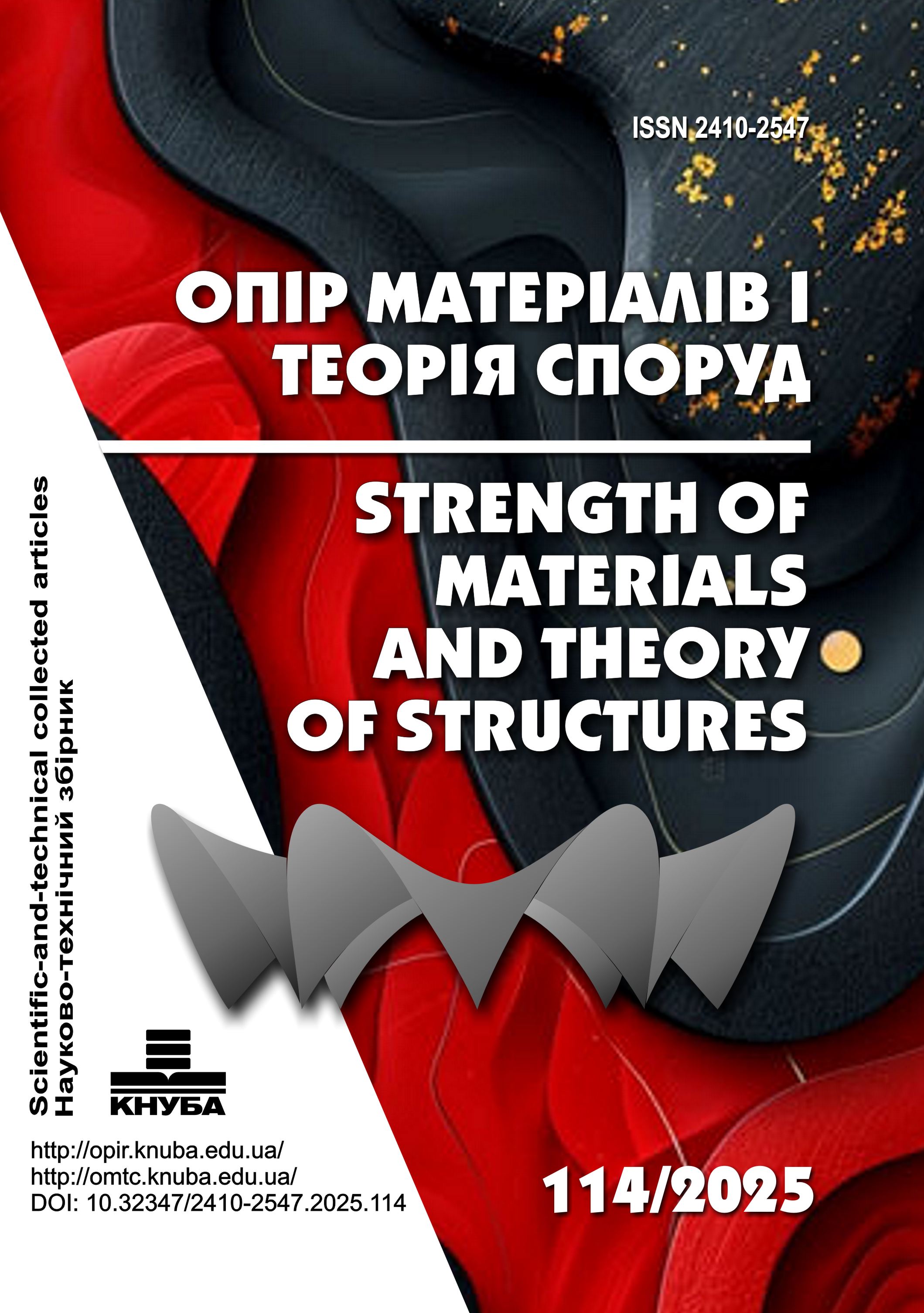Comparative analysis of the stress state of a bolted joint based on an analytical approach using SFEM and experimental results
DOI:
https://doi.org/10.32347/2410-2547.2025.114.3-10Keywords:
semi-analytical finite element method, finite element method, bolted connection, contact stresses, experiment, uniform heating loadAbstract
The main types of connections are welded, riveted, and bolted. Bolted connections have many advantages over other types of connections, namely: high manufacturability, reliability, and speed of installation work, so we will further consider various approaches to modeling bolted connections.
One of the most crucial and important points in the design of a structure is the calculation of the connection elements of the components, since the reliability of the structure as a whole depends on the accuracy and reliability of the calculation results.
For a wide range of tasks, the finite element method (FEM) is often used in calculations; this numerical method has proven to be one of the most common and versatile. When calculating elements of assemblies such as bolts, rivets, etc., simplified design schemes are usually used, but this approach does not allow for a complete analysis of the distribution of forces. For a complete analysis, it is necessary to create detailed spatial models, which in turn leads to the need to solve systems of high-order equations. To increase the efficiency of the FEM, it is necessary to combine it with the method of distribution of unknowns, as a result, the resulting approach is called the semi-analytical finite element method (SFEM).
The bolt, bolt head, and nut were modeled by spatial elements, and the bolt tension was modeled by a load from uniform heating.
The obtained results of the stress-strain state using the finite element method and the semi-analytical finite element method allow us to conclude that there is a slight difference in the stress distribution in the spatial formulation of the FEM and SFEM with experimental data and allowed us to identify a rational approach to modeling bolt tension.
References
Bazhenov V.A., Pyskunov S.O., Solodei I.I.. Chyselni doslidzhennia protsesiv neliniinoho statychnoho i dynamichnoho deformuvannia prostorovykh til (Numerical studies of the processes of nonlinear static and dynamic deformation of spatial bodies) // K.: Karavela, 2017. – 305 p.
Vabishchevych M.O., Storchak D.A.. Solution of nonlinear contact problems of deformation of nodal connections of steel structures // Opir materialiv i teoriia sporud. –K.:KNUBA, Vyp.108, 2022, P. 178-179.
Pysarenko H.S., Kvitka O.L., Umanskyi E.S.. Opir materivaliv. Pidruchnyk (Resistance of materials. Textbook).-2 edition., dopov. I pererobl. – K.:Vyshcha shk., 2004. -655 P.
Piskunov S.O., Mitsiuk S.V., Mitsiuk D.V., Repiakh Y. Analysis of the stress state of the bolted connection taking into account the bolt tension // Resistance of materials and theory of structures: scientific and technical collection - Kyiv: KNUBA, 2024. - Issue 113. - P. 44-49..
Piskunov S.O., Mitsiuk S.V., Mitsiuk D.V., Repiakh Y. STRENGTH ANALYSIS AND FORCE DISTRIBUTION IN A TENSILE METAL // Resistance of materials and theory of structures: scientific and technical collection - Kyiv: KNUBA, 2024. - Issue 113. - P. 44-49.
Prohramnyi kompleks LIRA-SAPR. Pryklady rozrakhunku i proektuvannia. K.; https://www.liraland.ua/download/private/lira/2023/lira_sapr_examples_ua.pdf.
Solodei I.I., Kozub Yu.H., Stryhun R.L., Shovkivska V.V. Chyselnyi analiz napruzheno-deformovanoho stanu trubchastoho elementa pry termosylovomu navantazhenni (Numerical analysis of the stress-strain state of a tubular element under thermoforce loading) // Opir materialiv i teoriia sporud. –K.:KNUBA, Vyp.109, 2022, P. 109-119.
Bazhenov, V. A., Pyskunov, S.O., Maksym’yuk Yu. V., Mytsyuk S. V. Effect of geometric nonlinearity on the life of a herryingbone lock joint in creep // Opir materialiv, 2022, Vol. 54, No. 3, pp.372-376.
Bolt Pretension Object. Modeling the Bolt and Preload. Ansys//https://innovationspace.ansys.com/courses/wp-content/uploads/sites/5/2020/10/2.2.3_Bolt-Pretension-Object_new_brand.pdf.
Bolting theory. Function of Bolts and Nuts.// https://www.enerpac.com/en-us/training/e/bolting-theory?srsltid=AfmBOopwGyGRyt4MitEuI1u7WnYTTincIFx4jnjmsWYgPoP5gGSBoQ3I.
Frederick F. Ling Contact Stresses and Deformations, ME EN 7960-Precision Machine Design Topic 7, 2007
Satheesh Kumar K.V., Selvakumar P., Jagadeeswari R., Dharmaraj M., Uvanshankar K.R., Yogeswaran B. / Stress analysis of riveted and bolted joints uasing analytical and experimental approach //Materials Today: Proceedings 42 (2021) 1091–1099.
Downloads
Published
Issue
Section
License

This work is licensed under a Creative Commons Attribution 4.0 International License.
Authors retain copyright and grant the journal right of first publication with the work simultaneously licensed under a Creative Commons Attribution License that allows others to share the work with an acknowledgement of the work's authorship and initial publication in this journal.

